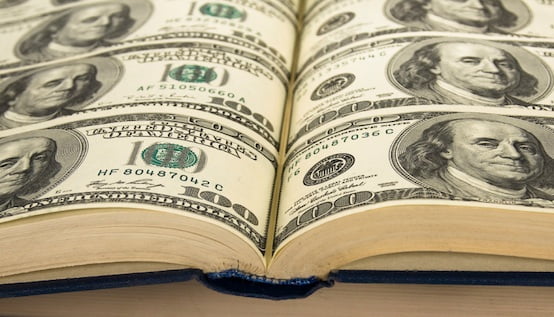
Ricardo Fayet offers impartial advice about how to measure the effectiveness of your ad campaigns
As paid advertising on various platforms becomes an increasingly important element of the indie author's marketing strategy, many are finding it hard to measure its effectiveness. Ricardo Fayet of ALLi Partner Reedsy offers some creative and clever means of tracking conversion and calculating return on investment (ROI) to help you decide whether your ads are paying their way. His Q&A format makes a complex subject easier to understand.
One of the things that annoys me the most about ebook retailers is that they give next to no data to authors.
Whether it’s Amazon, Kobo, Apple, B&N, or Google Play that we’re talking about, the only thing their dashboards and reports tells you is how many sales/downloads that you’ve generated for each book, and the amount of your royalty check.
There’s no demographics data, no referrer analysis, no read-through information, no landing page traffic or conversion numbers… And all that in an era where all other e-commerce players have all this data — and more — at their disposal.
In my opinion, this lack of data is what makes it so hard to market books. It leaves us with guesswork… and hacks. Which is what this Q&A-styled post is all about.
How do I know where my ebook sales come from?
You can’t. There’s literally no way to know it.
How can I estimate how many sales I’m getting through my Facebook ads?
You can use an Amazon affiliate URL to track that. I explained how that works and how to create an Amazon Associates account in this Reedsy marketing newsletter (to which you can also subscribe using the button in the top-right corner of that link).
Simply put, the great thing about affiliate links is that they’ll tell you how many people clicked on them and how many purchased after that touchpoint. It’ll also inform you what your Amazon on-page conversion is for each book.
Isn’t it strictly forbidden by Amazon to use affiliate links in ads?
Yes, it is against Amazon Associates’ terms of use. I’m stressing Amazon Associates, because it’s a 100% separate department from KDP. This means that if Amazon finds out about your use of affiliate links in ads, they might take down your Amazon Associates account. They won’t touch your KDP account.
So there’s a risk, but the risk is basically limited to losing the ability to use Amazon affiliate links.
How can I track the sales and conversion rates of different marketing channels?
By using different tracking codes within your Amazon Associates account. For example, you could set up an indieauthorfacebook-20 code for tracking Facebook ads and an indieauthorbookbub-20 for Bookbub ads.
Ah, and speaking of Bookbub ads: we have an awesome (and free) course written by expert David Gaughran that we just added to Reedsy Learning. As you might expect, it’s all about Bookbub ads. Take a look at it here!
How do I calculate my return on investment (ROI) on ads?
If you use affiliate links, it’s simple: check how much you spent on ads and how many sales these ads got you. Then, just use the following formula:
ROI = (Sales – Spend) / Spend
That said, if you write series and universes, there’s a good chance that a reader who buys one of your books will make their way through the rest of the series/universe. This is what’s often referred to as “read-through” or “sell-through” — and you should account for that when calculating ROI.
So how do I account for read-through?
Well, no retailer will reveal your exact read-through figures (i.e. the exact percentage of buyers of book 1 who go on to buy book 2, book 3, etc.). So you need to estimate them.
The best way to do this is to take a period of time (of at least 90 days) during which you ran no special promos on your series, and look at your sales report (I recommend using BookReport).
Then, simply divide your sales numbers to get your read-through:
- Read through to book 2 = # sales of book 2 / # sales of book 1
- Read through to book 3 = # sales of book 3 / # sales of book 1
- Read through to book 4 = # sales of book 4 / # sales of book 1
- Etc.
When doing your ROI calculations, remember to input these read-through figures.
Can you give me an example?
Sure. Let’s say you have a 3-book series, with book 1 priced at $0.99 (35% royalty) and books 2 and 3 at $3.99. Your read-through to book 2 is 60% and the read-through to book 3 is 50%.
How much is a sale of book 1 worth to you?
0.99*35% + 60%*3.99*70% + 50%*3.99*70% = $3.42
Next, let's say that a Facebook ad campaign is costing you $20 a day and generating at least 7 sales a day. Then your ROI would be:
ROI = (Sales – Spend) / Spend = ($3.42*7 – $20) / $20 = +19.7%
So keep it running — you’re making money!
And how do I account for KU reads?
It’s a little more complicated if you have to account for read-through and Kindle Unlimited, but it’s the same idea: you guesstimate what proportion of your income comes from KU reads and then apply that to your ROI calculations.
Practically, what you want to calculate is your KU borrows / sales ratio. To do this, just take a solid time period (of at least 90 days) and look at your figures in BookReport for sales and borrows. Then, just divide borrows by sales (this is what I call the “borrows / sales ratio”). For example, if BookReport tells you that you had 2,000 sales and 3,000 borrows, your borrows / sales ratio is 1.5.
What this ratio effectively tells you is the likelihood that an average reader coming across your book through an ad will borrow it on KU rather than buy it.
Finally, you can find out how much a borrow of each of your books is worth to you by multiplying the KNPC of your books by the current Amazon payout per page (you can find the latest figure in this helpful post by Written Word Media).
Then, you’ll just need to plug in these numbers in your calculations. To go back to my example above:
- 3-book series, with book 1 priced at $0.99 (35% royalty) and books 2 and 3 at $3.99;
- Read-through to book 2 is 60% and to book 3 is 50%;
- Overall Borrows/Sales ratio is 1.5;
- All books have a KNPC of 350 pages; and
- The latest KU payout per page is $0.0045.
According to our read-through calculations above, a sale of book 1 is worth $3.42 to you. But for every sale you’re generating through your ads, you’re also likely to generate 1.5 borrows of book 1 (which, in turn, will generate borrows of books 2 and 3)! And how much is a borrow of book 1 worth to you?
Value of borrow of book 1 = 350*0.0045 + 60%*350*0.0045 + 50%*350*0.0045 = $3.31
So, if we account for the possibility of KU reads, each sale of book 1 generated through ads is actually worth $3.42 + 1.5*$3.31 = $8.39.
I hate maths and didn’t understand a thing you said above! Do you have a spreadsheet that can do this for me?
Why, yes, of course. Copy the spreadsheet below to your own Drive or download the Excel version, instead — and only fill in the values in blue.
You can access the magical spreadsheet here.
How trustworthy are these methods?
As I mentioned in the introduction, retailers make it really hard for authors to market their books. All we have to work with are workarounds (affiliate programs) and guesstimates.
These guesstimates, in particular, are to be taken with a pinch of salt. For example, read-through is not a value that’s set in stone. It can vary a lot based on the type of reader you get in the first place. For example, if you run a free promo on book 1 for a week, you’ll get thousands of downloads, but only a fraction of them will turn into sales of books 2, 3, etc. So your read-through will take a hit.
If you use your “pre-promo” read-through for your ROI calculations on ads run through the promo, you’ll get incorrect (over-optimistic) results. What you should do, instead, is take a much more conservative read-through estimate. If you’ve run free promos in the past, dig into your past numbers and see what your read-through was after these promos. Use that value instead for your next one.
The same goes for your Borrows / Sales ratio. Depending on the audiences you target, and where you run your ads, you might want to use more conservative estimates. For example, if you have a high Borrow / Sales ratio and you’re running ads on Bookbub, you’ll want to use a much lower ratio, since Bookbub’s audience doesn’t tend to be KU-heavy.
What if I have more questions?
Well, that’s what the comments below are for!
#Indieauthors - struggling to work out whether your ads are profitable? Read @Reedsy's helpful post here - which includes a free spreadsheet to make it simpler! Share on XOTHER HELPFUL POSTS ABOUT ADVERTISING
From the ALLi Author Advice Center Archive




